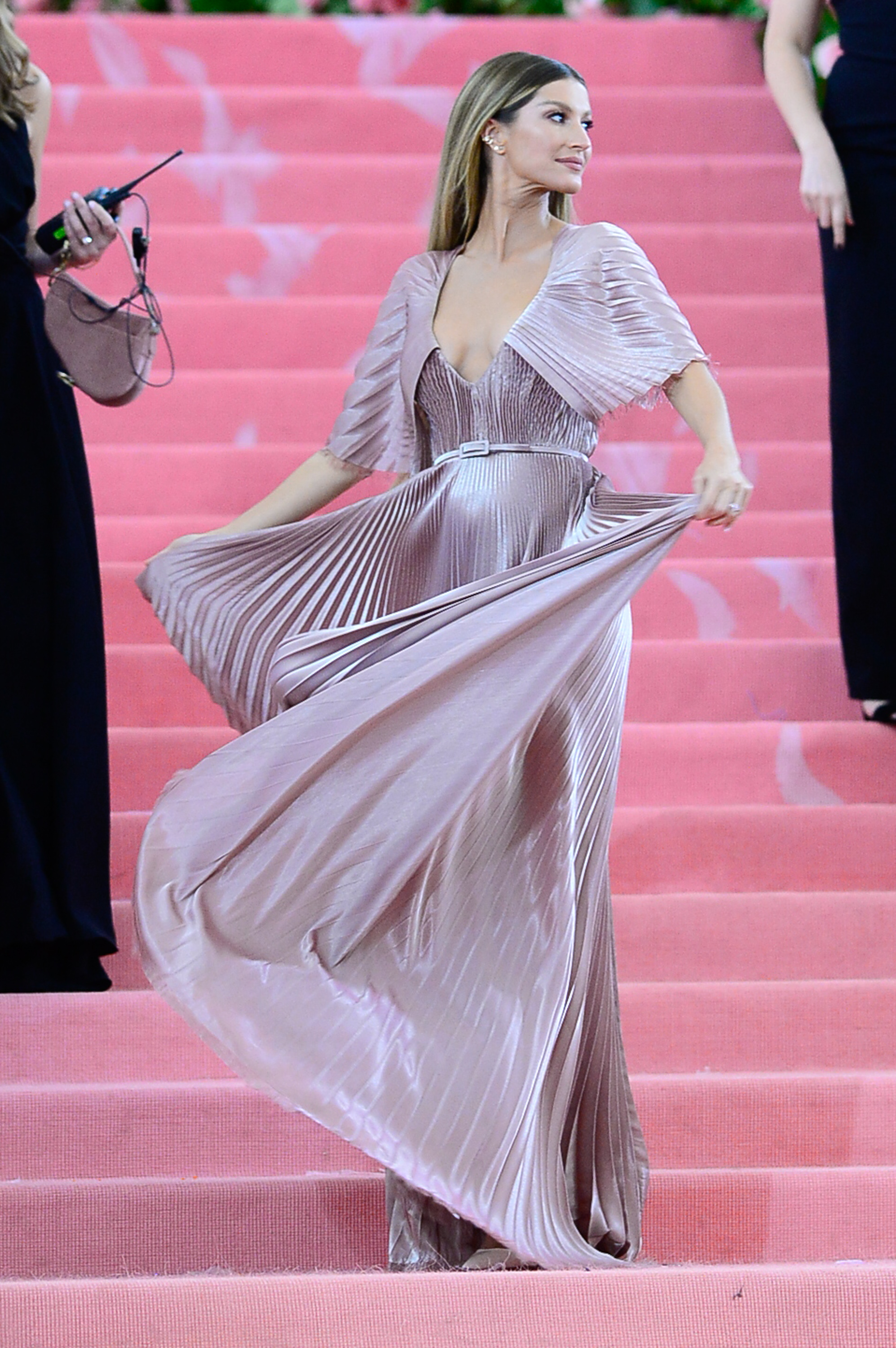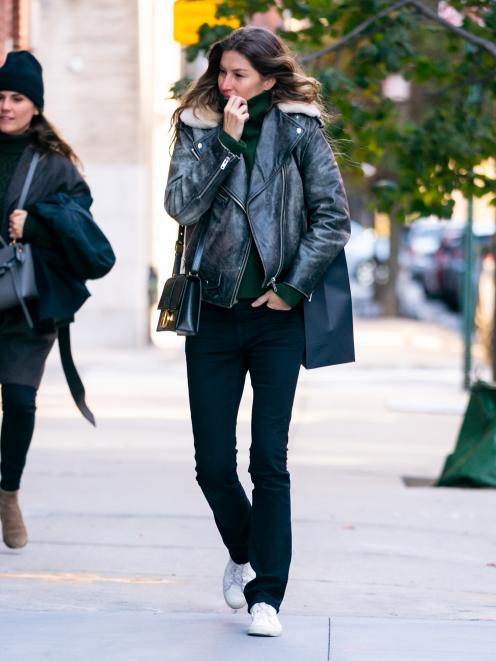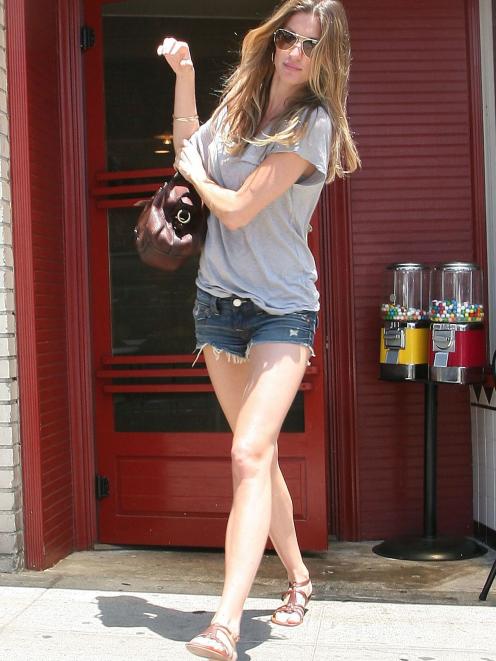For more than a decade, Gisele Bundchen was the world's highest-paid supermodel. But it hasn't always been so simple. She talks to Nosheen Iqbal about anxiety and hitting rock bottom, ethical activism and surviving Twitter storms.
In the grand exhibition space of a Shanghai art museum, molecular blobs have been blown up on giant screens to demonstrate the science element of a very long, very reverent summit on skincare hosted by Dior.

The celebrity element is Gisele Bundchen, the face of a new range of creams and serums, who will shortly be on hand to help quantify how 30 years of advanced floral science and stem cell technology can help you look better. Being born looking like one of the most successful models of the century can also help, but no matter.
"Health is becoming the new wealth," announces Edouard Mauvais-Jarvis, Dior's scientific communications director, to a room of 150 or so delegates. Gentle electronic music pulsates in a space with a Kubrick-meets-Instagram aesthetic: clinically all white, all bright, accented by pillars of pink peonies. Chic French PRs circle beauty journalists, editors and scientists, while kooky Asian influencers, like kooky influencers everywhere, take aloof but cute selfies.
Bundchen — or Gisele, as she's mononymously known — bounds onstage after being introduced via video montages of her career and the new Dior beauty campaign. There are lingering, soft-focus shots of her sitting with her eyes closed on a mountain or looking wistful on a beach, set to soaring strings. The emphasis is on the model's credentials as an environmentalist, activist, mother and paragon of physical perfection. Dressed in blue flared jeans, white shirt tucked into a Christian Dior belt underneath a myrtle green blazer with black kitten heels, her trademark wavy blow-out bounces as she takes a seat.
"I'm a big believer in your body being a temple," she says.
Her voice has a deliciously Brazilian-accented husk. She has been put in conversation on stage with Chinese actress Li Bingbing and a local TV presenter to talk about personal wellbeing and the planet.
"What are we eating? What are our thoughts?" Gisele asks the audience.
"Because when you feel better, you look better. And if we hurt nature, we're hurting ourselves."
The presenter blinks and nods before inanely suggesting that "if the environment gets clean and prettier, we will become clean and prettier".
Li looks fantastically bored. It is left to Gisele to carry the weight of the event, which she does with amped up professionalism: enthusiastic, chatty, smiling throughout. She talks about her environmental activism, the need for inner beauty and peace to be the main goal, and why nature is a "one-word philosophy" that allowed her to heal her wounds. The presenter, seemingly awestruck, closes her eyes and nods in agreement.
Gisele, pronounced Gi-zell-ee by her family, was 13 when she won her first modelling competition in Sao Paulo. She and her five sisters, including her twin Patricia, grew up in a middle-class home in a small town in southern Brazil.
She writes at length in her 2018 New York Times bestseller, Lessons: My Path to a Meaningful Life, about being bullied for looking too thin at school, of being a tomboy. The book is a hotchpotch of notes, a diary-come-scrapbook of her life and how she apparently got there. She writes about being name-called "Olly" (as in Olive, Popeye's skinny missus) and wearing "two pairs of pants to make my legs look thicker".
By the time Gisele arrived in New York, at 18, and made her catwalk debut for Alexander McQueen, she had been rebranded by him as "the Body" and as "the boobs from Brazil" by Dolce& Gabbana. The following year, in 1999, she became a sensation. Editors and designers declared the teenager, with her 36:24:35 bust:waist:hip ratio, marked the return of the curve; she rang the death knell for the waifish angles of heroin chic. Throughout the noughties, she was steadily the highest-paid model in the world, and has now clocked more than 1200 magazine covers.
"All I cared about back then was to be like this," she says, when we sit down together.
"Like, I wanted to belong, I wanted people to like me and it was important to me so I would go out of my way to say yes to everybody. I wanted to please everybody. God forbid I would, like, disappoint anyone. And hey, that's why I got panic attacks."
Gisele was at the height of her modelling career when, she says gravely, she "hit rock bottom".

"I was eating steak and fries every night. I was drinking a bottle of wine and smoking cigarettes and having a mocha cappuccino for breakfast. That wasn't so good."
For many this might qualify as an average Friday, but as a world-famous model Gisele developed severe anxiety.
"It was uppers and downers, it wasn't drugs, but I couldn't sleep because I was drinking so much coffee during the day."
In her book, she wrote that for the briefest split-second, feeling trapped, she looked out to the balcony of her apartment and considered a dark feeling. She lifts both hands from her lap now and chats at speed.
"When I had a panic attack, I thought I was going to die. I was scared. I couldn't breathe. And what I realised was that I am creating this for myself: we are creating the lives we are living with our actions and we have a choice. I chose to come into [my routine] because it was a tool that I found to heal myself."
The episode marked a pivot to a newer, even more virtuous life. Gisele took up yoga, meditation, silent retreats, cut out sugar, alcohol, caffeine, carbs — every health kick that has since become so mainstream as to be unremarkable.
Before Instagram, before Goop, before vloggers and a global wellness industry worth $4.2trillion, there were celebrity gurus and faddy diets. There were hooey health tips plucked from beautiful, famous people and the army of nutritionists, trainers, doctors and dermatologists that kept them so. In this sense, Gisele was an early adopter.
How does she feel seeing wellness and all she lived by transform pop culture?
"I have five sisters, and if I find a new recipe or something I like, I share it with the group. This is why I've written the book. The whole point is more awareness, the more people get things like yoga, it's a positive thing. The more people become awakened and conscious of the very decisions they're going to make, then you don't have a bunch of people, like, half asleep, you know?"
All but one of her sisters, who is a federal judge, work (in various, not altogether clear ways) for the wellness brand worth hundreds of millions of dollars that Gisele has built around herself over the past two decades. Hers is a sun-kissed, barefoot hippy, organic aesthetic contrived as a lifestyle catalogue: all yoga poses at sunset and cosy sweaters and leggings, with inspirational mantras for simple, fuss-free, eco-living.
Now, every morning, Gisele wakes up to the sound of ocean waves from her phone speaker and begins a fastidious routine. Stretches and meditation come first, followed by swilling oil in her mouth for several minutes "to clean out all the guck and detoxify teeth and gums". Then a workout listening "to a YouTube video on maybe ancient Egypt or Greece," followed by drinking lemon and water, making healthy breakfasts and lunches for her kids, and sipping a green juice.
The school run and a shower are completed before she begins her work in her garden office, the Sanctuary.
Gisele swears she does not find the regime difficult: most of her meals are plant-based and snacks such as roasted pumpkin seeds are considered a treat.
"I do it because it makes me feel better. It makes me happier in my life. I make those choices because it gives me something right back. And I'm happy that more people are getting access to that because the more people who know about it, the more it's going to make them happier. And if you have a happier world, the better it's going to be."
Gisele's logic is as sunny and indefatigable as her disposition. A lot of people may strive to live like her, I say, but often the discipline gives way to more urgent priorities.
"They just have to make the decision of working at it," she says earnestly.
"That's the problem with today's society, people want instant gratification where it's you know: ‘I want to do something and [when] I wake up I want to look like this’. I'm like, ‘er, well, you know for me to cure my panic attacks, it took months. I could have taken a pill, but I decided no. I'm going to wake up every morning and I'm going to meditate and do breath work.' It took months."
Which is fair, to a point. But not everyone has access to the financial and physical support she has.
"Everything starts with discipline," she says.
If Gisele's lifestyle now is the warped embodiment of aspiration, it is one she has carefully curated. She split from DiCaprio in 2005, after it became clear he was not on the same journey, so to speak. In 2009 she married the NFL star Tom Brady, after three years of dating. They have a 10-year-old son and an eight-year-old daughter together, along with Brady's 12-year-old son from his previous relationship with actress Bridget Moynahan.
Gisele and Brady's love has a cookie-cutter wholesomeness. At their wedding, they gifted each guest a copy of pop psychology guide The Mastery of Love. Forbes has named them one of the top three highest-earning celebrity couples of the past decade.
When Brady's friendship with Donald Trump caused a sensational backlash, it was Gisele who distanced the couple from the president. As Brady put it: "I talked to my wife and she said I can't talk about politics any more. I think that's a good decision for our family."

"I've been with my husband for more than 12 years now and, as you know, men are very ... They want a lot of attention. They're like, they demand ... They need a lot of attention, like children do, like your family, your friends. So I think the important part is to have fully present moments with everybody. I think that leads to fulfilment, because they don't have half of you, they have all of you in that moment and then they get recharged."
Gisele seems to have cracked this one. Despite the clock running down and her neat ability to filibuster rather than answer all my questions, she holds perfect eye contact and maintains she is "fully here and I'm having this experience and having an exchange. I'm not picking up my phone or texting somebody or thinking about my laundry or my dogs. It's the same thing with my kids. When I'm with them, I'm with them, on the floor with them, talking with them, really listening to them. Same with my husband."
After a decade of backing tree-planting reforestation initiatives in Brazil and launching a clean water project in her hometown, Gisele's environmental activism is set to step up. Her Instagram feed, written in Portuguese and English, is often scattered with missives that remind followers to take better care of the planet.
Given her life at home and with work, is her carbon footprint a worry? Is she aware of what it is?
"I've been working on something, but I can't say it right now. It has to do with the movement of regenerating the planet," she says.
"I do everything I can do. We compost. We have a garden. Yes, I could probably live in a smaller house, but we have solar panels. I tell my children it's about the three Rs: reduce, reuse, recycle. If you go into my closet, for example, you're not going to believe it, because I have, like, the jeans I wore three years ago."
It feels churlish to point out that in the civilian world, this is totally normal.
Gisele's life exists on a plane of fabulousness because, well, surely, that is entirely the point of being Gisele.
"That's how I am," she adds, still keen to maintain low-key relatability.
"I don't need stuff. When you need stuff it's because you haven't really worked out the inside."
We both laugh, given the irony of the statement coming from someone working in the fashion industry.
"The fashion industry is not what I've done ... It's what I do for work. And also, I haven't really done a lot of stuff because I feel like it's not in alignment with what I believe in. I say no to 95% of things that come to me."
Given that she turns 40 this year and is fronting a line of anti-ageing products, I ask how much she worries about her face and body changing as she gets older.
"I think, for me, it's more about the way I feel, you know what I mean? It's like, I breastfed my kids for three years each because I felt it was the most important thing I could do and I wanted to give my children and myself that experience — you're not going to have that again. Yes, it's going to make your body change, yes I can work out to be fit and feel good and rejuvenated, but I can't change the fact that both my kids liked the left boob."
In 2010, at 30, Gisele said that "there should be a worldwide law, in my opinion, that mothers should breastfeed their babies for six months."
In 2015, seemingly going against her own well-pronounced principles on keeping all things in life natural, she was papped in Paris visiting a plastic surgeon for surgery on said left boob. Aware of the backlash that would ensue amid charges of hypocrisy, she bizarrely tried to disguise herself in a burqa but was caught out by paps who recognised her driver. She was ridiculed brutally online.
"When I did that, I felt like I was trying to please. Because I was ‘the Body' and ..." She takes the briefest pause. "Look, I think if you do something because it is what you feel is your truth, then there is no problem. Then whatever you do is going to bring you joy. But if you do it because it's somebody else's idea of you, that's the problem. So that was another lesson that I've learned the hard way. I feel like today, where I'm at with my life, I don't really care what anyone thinks. I care about living my truth. I care about being a great mother."
She won't elaborate on her feelings about getting older, suffice to say that again, "I mostly like to be outside with nature, doing something physical like surfing, horseback riding, I play volleyball, run around with my kids or take my dog for a walk. I don't really exercise because I think I want my butt to look good or this way."
She smiles, fixed on wellness guru autopilot.
"It's important to do those things that really nourish you, benefit you, make you feel good," she ends. "I think that's vital."
— Guardian News and Media 2020











